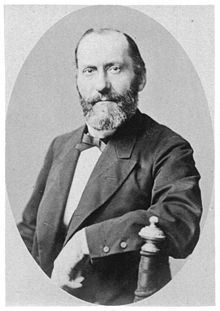Ernst Christian Friedrich Schering
Ernst Christian Friedrich Schering (born May 31, 1824 in Prenzlau ; † December 27, 1889 in Charlottenburg ) was a German pharmacist and entrepreneur in the chemical industry .
Early years
Schering was born the youngest of five children to an innkeeper . His parents wanted him to become a pharmacist. One of his older brothers had made it to the Council of Justice . He himself absolutely wanted to become a forester because he saw the work of a pharmacist as unhealthy and the establishment of a pharmacy required a lot of money. When he finally gave in to the pressure of his family, he demanded training at the Apulius'schen Apotheke, the best pharmacy in Berlin. After his apprenticeship, he worked as a pharmacy assistant in various pharmacies, including in Berlin. Here he studied pharmacy from 1848 . After graduating as a "first class pharmacist" on August 6, 1850, he was allowed to run a pharmacy in Berlin.
Career
In 1851 Schering bought the Schmeisser'sche Apotheke on Chausseestrasse near the Oranienburger Tor on the northern edge of what was then Berlin (today Berlin-Mitte ), which he soon renamed "Green Pharmacy" due to his love of nature. At that time he lived in the same house with his family. Starting in 1854, in a small laboratory behind his sales room, he successfully endeavored to produce chemicals of particular purity that should not harm the health of patients. He also produced the high-purity materials required for developing photography . Around 1865 he joined the Société française de Wothlytypie and received the license to produce pictures using the new Wothlytypie process with special chemicals.
At that time there were no standardized recipes and technologies in chemistry and pharmacy; every pharmacist used his own methods reminiscent of alchemy . At the Paris World Exhibition in 1855 he presented his “pure preparations” and won a silver medal. Due to the great demand, he began in the same year to develop a chemical production facility separately from the pharmacy, for which on September 21, 1864, under the company Chemische Fabrik Ernst Schering, he obtained the state concession to build the main factory on the property at Müllerstrasse 171 in Berlin- Wedding received. In 1867 Ernst Schering was one of the founders of the German Chemical Society , whose treasurer he was until 1880. The court photographer Jacob Wothly had his photo chemicals made in his laboratory . In the Franco-Prussian War of 1870/71 , Schering's company was commissioned to supply the army with medicines , which earned Ernst Schering the title of Kommerzienrat and enabled him to turn his company into a stock corporation under the name of Chemische Fabrik auf Actien (formerly E. Schering) to convert. This later became Schering AG . The pharmacy was meanwhile continued by his son Richard Schering and in 1881 it was moved to the R. Schering factory chem.-pharmaz. Preparations converted. It was expropriated in the Soviet occupation zone in 1946 and relocated to Lübeck , where it continues to exist in family ownership as Blücher-Schering GmbH & Co. and produces drugstore items.
Late years
In his company, Ernst Schering provided social security for his employees even before the statutory regulations. A free aid fund ( company health insurance fund ) was established as early as 1876, a civil servants 'and workers' pension fund in 1879 and a widows 'and orphans' fund in 1892. His reservations about the unpopular profession were confirmed in long-standing health complaints that forced him to resign from the management board and to switch to the supervisory board of his company in 1882 .

Ernst Schering died in Charlottenburg in 1889 at the age of 65. He was buried in the Schering family's hereditary funeral in Berlin Cemetery III of the Jerusalem and New Churches in front of the Hallesches Tor . The lattice grave has been preserved. A black granite zippus with a bronze medallion with the portrait of the deceased in profile, the work of Gustav Landgrebe, serves as the gravestone for Ernst Schering .
In Berlin, the Scheringstrasse (named 1894), the Ernst-Schering-Oberschule (named 1984) and a memorial plaque on the house at Müllerstrasse 170 (since 1988), all in Wedding (Berlin-Mitte) commemorate Ernst Schering. In 1968 the Scheringgasse in Vienna- Penzing (14th district) was named after him.
In 1991, the Schering Research Foundation established the Ernst Schering Prize, endowed with € 50,000 , which has been awarded annually since 1992 for particularly outstanding scientific pioneering work in the field of basic scientific research, especially biology , medicine and chemistry . The Schering Foundation has been awarding the award since 2003 .
literature
- Christine Berghausen: Schering, Ernst Christian Friedrich. In: New German Biography (NDB). Volume 22, Duncker & Humblot, Berlin 2005, ISBN 3-428-11203-2 , p. 697 f. ( Digitized version ).
Web links
- biography
- Schering Foundation
- The former main laboratory has functioned as a museum since 1986: The Scheringianum
Individual evidence
- ^ Hans-Jürgen Mende : Lexicon of Berlin burial places . Pharus-Plan, Berlin 2018, ISBN 978-3-86514-206-1 , p. 246.
| personal data | |
|---|---|
| SURNAME | Schering, Ernst Christian Friedrich |
| ALTERNATIVE NAMES | Schering, Ernst (common attribution) |
| BRIEF DESCRIPTION | German pharmacist and entrepreneur in the chemical industry |
| DATE OF BIRTH | May 31, 1824 |
| PLACE OF BIRTH | Prenzlau |
| DATE OF DEATH | December 27, 1889 |
| Place of death | Berlin |

